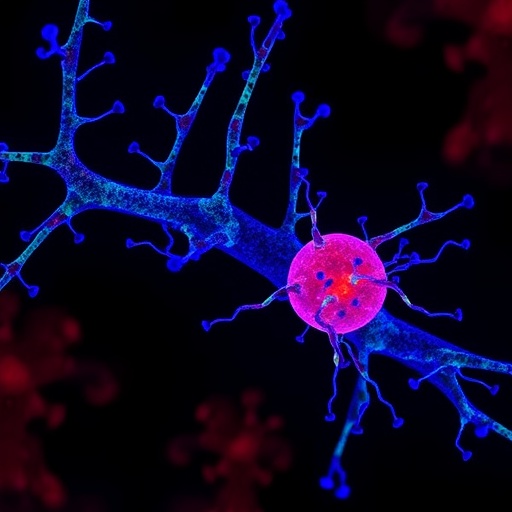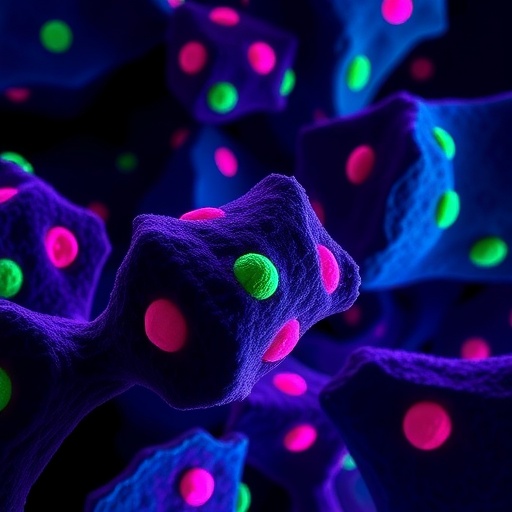In a groundbreaking study published recently in Medical Oncology, scientists have uncovered the pivotal role of Ephrin B3, a member of the Ephrin protein family, in orchestrating the aggressive progression of cutaneous squamous cell carcinoma (cSCC). This malignancy, which originates from the squamous cells in the epidermis, is notorious for its ability to invade locally and metastasize, posing significant therapeutic challenges. The research delivers compelling evidence that Ephrin B3 is not merely a passive player in tumor biology but actively drives tumorigenesis and potentiates inflammation within the tumor microenvironment, contributing to the malignancy’s relentless progression.
Cutaneous squamous cell carcinoma represents one of the most common skin cancers worldwide, often developing on sun-exposed areas of the skin. Despite its prevalence, the molecular mechanisms underlying its initiation and progression remain incompletely understood, limiting the development of targeted therapies. Ephrin B3 belongs to the ephrin ligand subclass known to engage with Eph receptors, forming a bidirectional signaling system essential for cellular communication, migration, and adhesion. Dysregulation of Ephrin-Eph signaling pathways has been implicated in various cancers; however, elucidating the specific contributions of Ephrin B3 in the context of cSCC fills a critical knowledge gap in oncology.
The study utilized a comprehensive combination of molecular biology techniques, including gene expression profiling, immunohistochemistry, and in vivo tumor models, to delineate the function of Ephrin B3 in cSCC. Data demonstrated that Ephrin B3 expression was markedly elevated in tumor tissues compared to adjacent normal skin, correlating strongly with markers of cellular proliferation and inflammatory cytokines. This upregulation was shown to potentiate oncogenic signaling cascades, notably affecting pathways associated with cell cycle regulation and apoptosis resistance, thereby fostering an environment conducive to uncontrolled cell growth and survival.
.adsslot_9Zt50XNs2C{ width:728px !important; height:90px !important; }
@media (max-width:1199px) { .adsslot_9Zt50XNs2C{ width:468px !important; height:60px !important; } }
@media (max-width:767px) { .adsslot_9Zt50XNs2C{ width:320px !important; height:50px !important; } }
ADVERTISEMENT
Inflammation is a known hallmark of cancer, often driving progression and metastasis through the recruitment of immune cells and the release of pro-inflammatory mediators. Intriguingly, the research highlighted an intimate link between Ephrin B3 expression and inflammatory signaling in cSCC. Elevated Ephrin B3 was found to modulate the tumor microenvironment, promoting the secretion of key inflammatory cytokines such as interleukin-6 (IL-6) and tumor necrosis factor-alpha (TNF-α). This cytokine milieu not only sustains chronic inflammation but also reinforces tumorigenic signaling loops that exacerbate malignancy.
Further mechanistic insights revealed that Ephrin B3 facilitates crosstalk between epidermal tumor cells and infiltrating immune cells, thereby establishing a feedback loop that amplifies both tumor growth and inflammation. By engaging Eph receptor tyrosine kinases, Ephrin B3 activates downstream effectors like Src family kinases and the MAPK/ERK pathway, which are critical mediators of proliferation, invasion, and migration. This signaling output culminates in enhanced tumor aggressiveness, increased metastatic potential, and resistance to apoptosis, underscoring the protein’s dual pathogenic role.
The interplay between Ephrin B3-mediated signaling and the tumor microenvironment also provides a fertile ground for synergistic therapeutic strategies. Coupling Ephrin B3 blockade with immunotherapeutic agents could potentiate antitumor immune responses by disrupting the inflammatory landscape that tumors exploit to evade immune surveillance. As immune checkpoint inhibitors gain traction in oncology, understanding how Ephrin B3 modulation influences immune-cell infiltration and function becomes paramount.
Moreover, this study adds a new dimension to the broader understanding of Ephrin family proteins in tumor biology. While earlier research had implicated other Ephrins in different cancer types, the identification of Ephrin B3’s specific role in cSCC expands the repertoire of potential biomarkers and targets within this signaling axis. Importantly, the differential expression pattern of Ephrin B3 in malignant versus normal tissues could enable its use as a diagnostic or prognostic marker, aiding in early detection and risk stratification of cSCC patients.
The investigation into Ephrin B3’s role was not limited to tumor cells alone; the researchers also explored its impact on stromal cells, including fibroblasts and endothelial cells within the tumor milieu. Ephrin B3 signaling was shown to enhance angiogenesis—a crucial process for tumor sustenance—through upregulation of vascular endothelial growth factor (VEGF) and other proangiogenic factors. This angiogenic impetus ensures a steady supply of nutrients and oxygen, facilitating tumor expansion and metastatic dissemination.
Interestingly, the molecular insights provided by this study also hint at an evolutionary conserved function of Ephrin B3 in tissue repair and inflammation, which cancer cells seem to hijack to fuel their pathogenesis. The hijacking of physiologic pathways by oncogenic processes is a recurring theme in contemporary cancer biology and understanding these intertwined mechanisms provides a roadmap for developing interventions that specifically disrupt tumor-favoring adaptations without harming normal tissue function.
Given the complexity of Ephrin-mediated signaling networks, the authors emphasize the need for further research to map out the context-dependent effects of Ephrin B3 in diverse cellular compartments. They call for investigations into how Ephrin B3 interacts with other receptor tyrosine kinases and intracellular signaling nodes to unveil combinatorial targets that could maximize therapeutic efficacy while minimizing resistance mechanisms.
The translational potential of these findings cannot be overstated. With cSCC incidence rising globally, especially in aging populations and immunocompromised individuals, innovative treatments are urgently needed. Ephrin B3-directed therapies could complement emerging modalities such as photodynamic therapy and molecular targeted agents, offering hope for improved patient outcomes in a disease that can often have disfiguring and life-threatening consequences.
In summary, this seminal work elucidates the multifaceted role of Ephrin B3 in driving tumorigenesis and inflammation in cutaneous squamous cell carcinoma and highlights the protein as a promising target for therapeutic intervention. By bridging molecular signaling with the inflammatory tumor microenvironment, Ephrin B3 emerges as a central node in cSCC pathophysiology, embodying the complex interplay between cancer cells and their neighboring stromal and immune cells. The findings propel forward our understanding of skin cancer biology and lay the groundwork for novel, effective treatments that could revolutionize patient care.
As oncology moves toward personalized medicine, identifying such key molecular drivers within specific cancer subtypes will be crucial. The research conducted by Kang, Wang, Feng, and their colleagues exemplifies a paradigm where deciphering intricate signaling pathways culminates in tangible clinical opportunities. Future clinical trials assessing Ephrin B3 inhibitors, either as monotherapies or in combination with immunomodulators, will determine the true impact of this discovery on the therapeutic landscape of cutaneous squamous cell carcinoma.
The road from bench to bedside for Ephrin B3-targeted strategies might still be unfolding, but the promise that this molecule holds as a disruptor of tumor-promoting inflammation and growth represents a thrilling advance in skin cancer research. As scientists continue to unravel the complexities of tumor microenvironments and oncogenic signaling, Ephrin B3 stands out as a beacon of hope in the quest to conquer one of humanity’s most tenacious and common cancers.
Subject of Research: The role of Ephrin B3 in tumorigenesis and inflammation in cutaneous squamous cell carcinoma.
Article Title: Ephrin B3 drives tumorigenesis and inflammation in cutaneous squamous cell carcinoma.
Article References:
Kang, N., Wang, Z., Feng, Y. et al. Ephrin B3 drives tumorigenesis and inflammation in cutaneous squamous cell carcinoma. Med Oncol 42, 374 (2025). https://doi.org/10.1007/s12032-025-02922-y
Image Credits: AI Generated
Tags: aggressive skin malignanciesbidirectional signaling in cancercutaneous squamous cell carcinoma progressionEphrin B3 role in cancerEphrin-Eph signaling pathwaysepidermis-derived tumorsmolecular mechanisms of cSCConcology research advancementsskin cancer therapeutic challengestargeted therapies for cSCCtumor microenvironment inflammationtumorigenesis in squamous cell carcinoma





